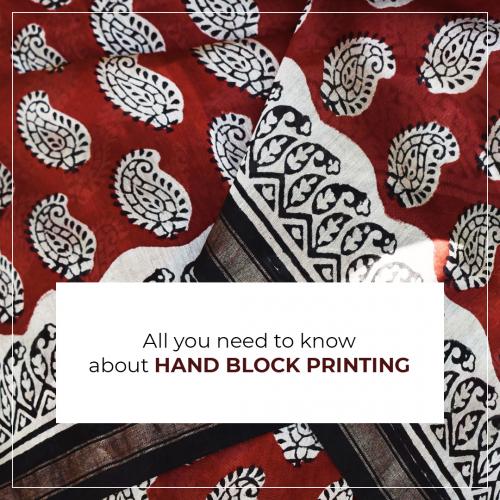All You Need to Know About Hand Block Printing

Hand block printing is the Indian
traditional art of cloth-making, it’s eco-friendly, represents and respects
nature and the most important thing is that it’s India original and age-old way
of fabric printing.
The artisans who make these
incredibly beautiful fabrics are the pride of the nation as they are supporting
the country’s culture and tradition.
This article will tell the reader all
they need to know about this ancient treasure.
What is hand block printing?
Before the reader can know about hand
block printing, they must also know about textile printing, just in brief,
nothing more.
The technique of applying distinct
colors and designs on fabric so that the color will not fade on washing or when
friction is applied on them is known as textile printing.
Hand block printing is the
traditional style of textile printing from India, in which blocks are carved in
a specific design then dipped in ink, and then stamped at different lengths of
fabric making unique and beautiful patterns.
The patterns such as flowers,
animals, and several abstract designs not only represent nature but also give
an interesting look to a simple fabric.
The blocks
The wooden blocks used are carved
from the wood of shisham and sagwan trees, they vary and size and are 2 or 3
inches thick for ease of use, they are of two types, one is gadh for filling in
the design and the other is rekh for outlining it.
Metal blocks are also used, even
though they are more expensive and take time to make; they last longer than
wooden blocks.
The designs carved on the blocks are
of three types.
- Geometric patterns (lines and geometrical motifs).
- Floral designs (paisley, flowers, tree leaves).
- Tribal designs that represent the daily life of tribal
people.
A hand block print fabric from India
features earthy tones and motifs that are an inspiration from nature, village
landscape, and mythology, a block print consists of certain basic components of
Buti, Jhal, Bel, and Buta in the form of small patterns.
The steps of creating a block print
fabric
The hard-working process of Indian
hand block printing from start to finish is appreciable; the traditional colors
used for printing are red, black, brown, mustard and orange.
1)
Block
carving.
2)
Application
of dye.
3)
Treatment
of fabric.
4)
Printing.
5)
After
treatment.
Hand block printing techniques
This unique art can be done in
various ways; craftsmen can choose the technique that suits them.
Direct hand block printing: - The cloth is given a light background
by bleaching first and then dying, after that the outlining blocks are put to
work first followed by the filling blocks.
Resist printing: - Areas of the fabric are protected
from the dye by a cover made from clay and resin, then it is died and washed,
the dye spreads to the protected areas through cracks.
Discharge printing: - A chemical is applied to the fabric
after dying to deteriorate it from selected areas; these areas are then fixed
and recolored.
Hand block printing types
Kalamkari in Madhya Pradesh: - The fabric is printed by a pen, which
gives it the name kalamkari, because kalam means pen in Hindi.
Sodagiri prints in Gujarat: - Resist printing is used to make
designs of dancing girls, birds, and animals in red and black.
Dabu and ajarakh in Rajasthan:
- What makes it
unique among the types are the colors used, they are black, red, blue, and
beige.
Bagh prints in Madhya Pradesh:
- Based on the
town called Bagh in Madhya Pradesh, this type uses vegetable and natural dyes
in bright shades of red, black, and indigo, the tonal and 3-dimensional prints
unique to this type are impossible to replicate using screen or machine
printing.
Hand block printing is also vastly
done in Uttar Pradesh and West Bengal.
This vast traditional textile culture
of India is what makes tourists visit the country and buy the amazing designs
from Jaipur Block Print Fabric Wholesale.
Post Your Ad Here
Comments